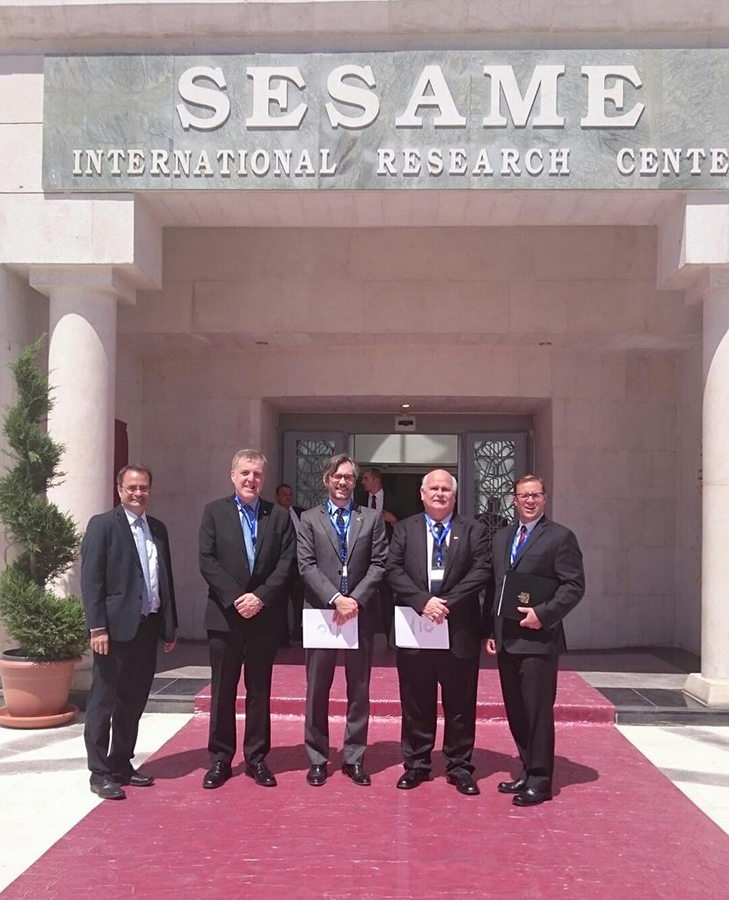Open SESAME: U of S building bridges in the Middle East through synchrotron science
SASKATOON – When the largest scientific project in the Middle East opens its doors May 16, the University of Saskatchewan (U of S)—home to the Canadian Light Source synchrotron—will be part of an international effort to use science for diplomacy in one of the world’s most volatile regions.

King Abdullah II of Jordan will attend the ceremony for the opening of the SESAME synchrotron facility, a collaboration of Israel, Iran, Cyprus, Egypt, Jordan, Pakistan, Turkey and the Palestinian Authority, whose scientists don’t often collaborate with one another.
Canada, which was recently granted observer status on the SESAME Council, will be represented at the event by the two Canadian delegates on the Council: a representative of the Government of Canada and Rob Lamb, director of the U of S-owned Canadian Light Source (CLS), Canada’s national synchrotron facility.
“We are proud to be part of this remarkable project which transcends politics and builds trust by bridging different cultures in the region and bringing together nations united by the common language of science and the shared goal of using the power of synchrotron light to benefit the region,” said U of S Vice-President Research Karen Chad.
Like the fabled “open sesame” command after which the Synchrotron-light for Experimental Science and Applications in the Middle East (SESAME) takes its name, the first synchrotron in the Middle East is expected to unlock a treasure trove of opportunities for the region’s scientists.
A synchrotron, which can be compared to an enormous flashlight, uses very brilliant light—many times brighter than the sun—to explore the properties of materials ranging from artifacts to semiconductors to viruses. There are about 70 synchrotrons in the world, but previously none in the Middle East.
Observer status opens the door to joint research initiatives for faculty and graduate students, exchanges, and training opportunities, including having SESAME researchers participate in CLS workshops and summer schools.
For instance, the CLS plans to bring two SESAME scientists to Saskatoon for a couple of months this year to use the CLS’s imaging beamline for the study of archeological artifacts from sites important to Middle East cultural heritage. The knowledge and experience gained will have applications to other areas of research including new materials, water and food security, and health.
The users of SESAME will mostly be in universities and research institutions in the Middle East and neighbouring regions.
Observer status will mean that Canadian academic and industrial scientists can build new collaborations and Canadian companies can now bid for equipment procurement contracts. The CLS will contribute in-kind support in the form of training and used synchrotron equipment.
Canada is one of 15 countries granted observer status on the oversight council of SESAME, a project set up under the auspices the United Nations Educational, Scientific and Cultural Organization (UNESCO). Brazil, China, Japan, Kuwait, Switzerland, the Russian Federation, the United States and European Union members France, Germany, Greece, Italy, Portugal, Spain, Sweden and the United Kingdom also have observer status.
“Canada’s joining SEASAME as an observer state will enable the Canadian Light Source (CLS) to partner with it for scientific co-operation and open a new market for its expertise,” said Ralph Goodale, Minister of Public Safety and Emergency Preparedness. “The CLS is a leading centre of excellence in synchrotron science and its applications. I was proud to help establish the CLS at the University of Saskatchewan and secure the funding for it while I served as Canada’s Minister of Finance, and it is gratifying to see this latest achievement.”
For more information, contact:
Murray Lyons
Media Relations Specialist
University of Saskatchewan
306-966-1851
murray.lyons@usask.ca

